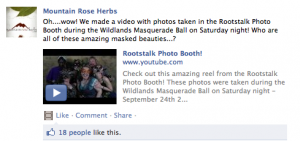Facebooking at the Tradeshow
While there are literally dozens, if not hundreds of things you could do to interact with Facebook while at your tradeshow, let’s look a few of the basics. Are you covering these?
Does your blog (assuming you have a blog) have a Facebook page widget inviting readers to connect (like) with you? That’s a must. Every one that likes your Facebook page through your blog is another person that you can connect with in another place. And the good thing is that they are able to do that without even landing on your Facebook page. If you don’t have a blog, at least put a widget on the front page of your website. They’re easily configurable, and easily found – just go here and follow the instructions. You may need the assistance of your web guy or girl to install the code, but really, it’s pretty simple!

At the show, plan to post photos and updates as often as time allows. Encourage people to upload their own photos of your booth and/or staff to their pages. People love to share, so make it easy. In fact, you might even create a special backdrop where they can have their photos taken. Get creative – put up a photo of Brad Pitt or someone famous, or perhaps a famous scenery such as Yosemite Valley or Grand Canyon, or some other place that might relate to your business.
If you have a smartphone, get the Facebook app set up on it, and log in before the big day. Spend a little time getting use to how to take photos and upload them to your company page. Once that’s done, you’ll have a much easier time doing it while in the chaotic time crunch on the show floor.
Once you’re to the point of posting photos from the show floor and encouraging visitors to do the same, don’t forget to monitor the page. No doubt you’ll be getting comments on a regular basis – or at least feedback on the photos. Chime in to the conversation and respond to questions or concerns. This is great customer service: not only do you show customers that you care; you show potential clients that you’re proactive about dealing with issues as they come up.
With Facebook usage and time-spent data continuing to ramp up, it behooves you to do the best you can to be a part.





